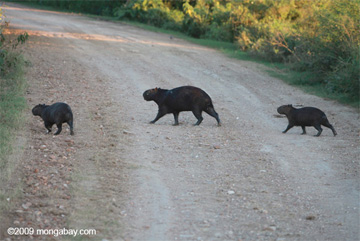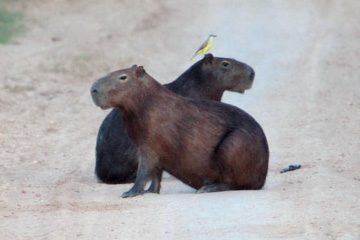Capybara are expanding into areas of deforestation throughout South America, reports a new study conducted by Kansas State University researchers and published in the journal of Global Change Biology. The study is the first to report capybara populations invading historically arid regions and finds that the presence of invasive capybara can hinder habitat restoration.
The capybara is the world’s largest rodent species. Topping out at 140lbs, capybara are semi-aquatic herbivores that can be found throughout tropical South America wherever permanent sources of water exist. Historically, this meant that they were confined to lowland grassy areas with rivers and swamps, but the conversion of forest into cropland and rangeland has created new habitat for capybara and has led to substantial increases in populations.
The presence of these invasive capybara populations can have detrimental effects on the environment. This is especially problematic when they occur in conjunction with cattle. While preferring grasses, capybara can alter their eating habits and, like cattle, browse on native vegetation which can result in an even greater impact on an already devastated ecosystem.
 Capybara in Brazil. Photo by Rhett A. Butler |
The team from Kansas State University studied the Gran Chaco, an ecosystem which comprises 1.3 million square kilometers in Argentina, Paraguay, and Bolivia. Most of the Argentinian portion has experienced extensive habitat loss as the native woodlands and grasslands have been converted to livestock pasture. Bolivian and Paraguayan Chaco regions show far less alteration, although economic pressures are increasing the likelihood that livestock will be moved into the region.
The Gran Chaco ecosystem is divided into high, central, and low regions. The low Chaco is characterized by floodplains, swamps, and tropical forests whereas the high Chaco is an area of thick, xeric forests from which water disappears entirely during the dry season. The aridity of the high Chaco should make it impossible for capybara to survive there, however they have recently started to colonize the region.
“Capybara have always been present in the low Chaco where year round water sources are abundant, and the habitat is more wetland based. The recent expansion is into the central and high Chaco, about a 50% increase in distribution within the Chaco region of Paraguay.” says Dr. Samantha Wisely, professor at KSU and coauthor of the recent study. “Deforestation opens up grazing habitat, and the water reservoirs that ranchers put up to provide year round water for their cattle provide the other habitat requirement for capybara.”
 Capybara in Brazil. Photo by Rhett A. Butler |
The researchers used a combination of ecological modeling and population genetic analysis to determine how recently capybara had invaded the Gran Chaco. They found that populations that had diverged tens of thousands of years ago are now intermixing.
“It’s clear from the genetic signal that the expansion has allowed two previously isolated populations to come together within the last few generations of capybara” says Dr. Wisely. “From a disease aspect, it means that diseases which were present in one population but not the other can spread to the naive population, possibly allowing diseases to amplify in the region.”
Dr. Wisely explains that habitat alteration not only poses a disease risk for capybara, but for humans as well.
“Zoonotic diseases (diseases shared by humans and animals) have dramatically increased globally in the last 25 years. There is increasing evidence that this increase in disease outbreak is caused by human induced ecological transformation. As we alter the ecological landscape, animals that have never previously shared habitat come into contact with each other and with humans which can facilitate disease transfer, and some animals which are better adapted to disturbed habitats can increase in number. If those populations carry disease, then the disease is also amplified.”
The study reports that agricultural and range expansion has altered the Gran Chaco ecosystem more than any other event in the past 2.5 million years, and will only increase if efforts are not taken to stop its transformation into pasture.
“(More than 2000 acres) of Chaco forest are being lost to deforestation every day, so the increase in capybara is only a symptom of a larger change that is occurring. The rise in beef prices, the influx of Brazilian ranchers to Paraguay, and the increased exportation of beef in Paraguay contribute to the increased pressure on the landscape. Paraguay enjoys some of the last remaining Chaco ecosystem. Chaco forest in Argentina is almost completely converted to pasture. Convincing the Paraguayan government that the Chaco forest is a national natural resource will be necessary to secure its continued existence.”
Related articles